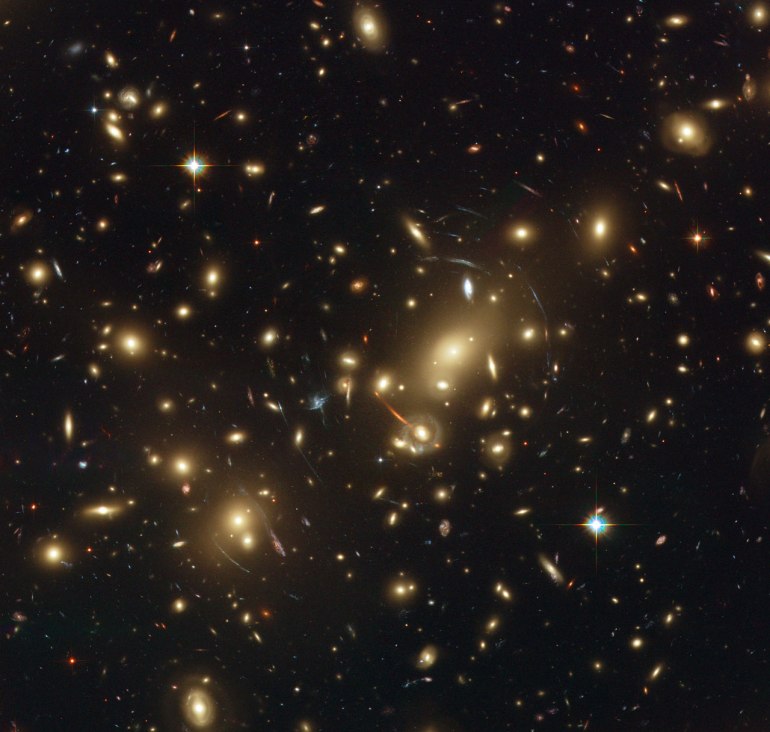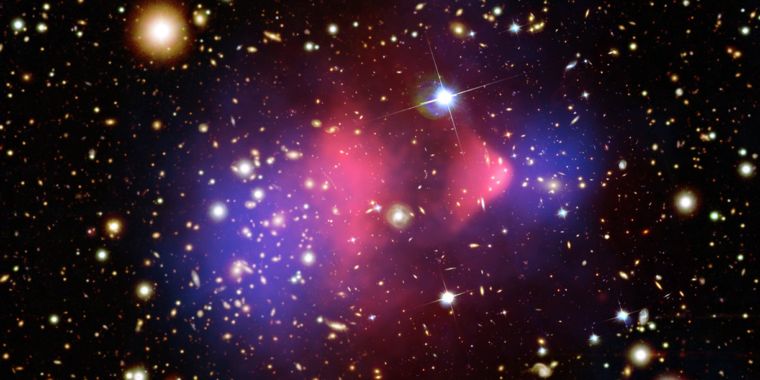Could I really claim to be interested in astronomy whatsoever if I didn’t express my overwhelming fascination with dark matter? Seriously though, I get the feeling that most people without a solid background in astronomy don’t grasp how much of a real phenomenon dark matter is. The name itself sounds like something made up from the likes of Star Trek, some brain child of a sci-fi TV writer desperate for “spacey” content in his script. What blows my mind? The fact that there is real, physical, concrete evidence for this matter. Despite the fact that humans have no way of perceiving it, as dark matter does not communicate its information through light or sound waves (or smell or touch or taste of any of our human senses, inconveniently enough) so we rely on phenomena we can observe in order to document it’s existence.
The first phenomena? Light. As we know, we can see light. Ok, great. Light also experiences wave/particle duality, meaning that it can be bent and warped by areas of high gravity. Dark matter is incredibly dense and makes up 80% of the mass in our universe, and therefore it also has the ability to affect visible mass via it’s incredible gravity. This effect is called gravitational lensing, when light rays are bent by areas of high gravity. We see this with light rays from distant galaxies- images of galaxies to appear curved, when in reality that are just being warped by dark’s matter’s gravity. See in the Abel 2218 Cluster, the light rays appear to be bent even though the galaxies themselves are flat.

The second main evidence for dark matter is inconsistencies within the velocity dispersion curves of galaxies. If you’ve never heard of velocity dispersions, it takes a little building up to get to the concept. Gravitational attractions between planetary bodies cause the formation of galaxies, and additional attraction between those galaxies causes them to form clusters with velocities that let the centripetal acceleration be equal to said gravitational force. The velocity dispersion curve is a representation of all the velocities for a given cluster. However, when actually calculating the velocities in relation to the gravitational force of the visible matter, it was found that the observed velocities were WAY too high to make sense. The only thing that would allow the galaxies to move at such high velocities would be the presence of much more mass within the galaxies. When the calculations were redone- taking the 80% mass of dark matter into account- it was then found that the observed velocities made perfect sense. If that isn’t concrete evidence for the existence of dark matter, I don’t know what is.
If this topic intrigues you as much as it intrigues me, I encourage you the explore other evidence of dark matter’s existence. (The bullet cluster collision, as pictured in the thumbnail for this entry, is a great place to start!) It’s incredible to me how we are able to perceive a literally imperceptible type of matter only through its effects. Cataloging such visual evidence is the first step to gaining a deeper understanding of the universe we occupy, and what I believe will lead to the next era of scientific discovery.

It’s amazing that we’ve gotten so good at analyzing light, aka the entire basis of astronomy, that we have started to characterize things that inherently don’t produce light. Dark matter is starting to make sense to us now, but I’m sure people in Aristotle’s day couldn’t have even conceptualized dark matter, among other 21st century ideas. I am intrigued to know what that kind of concept would be nowadays. If dark matter is just starting to make sense, what else don’t we know? What else is out there that we can’t even conceptualize yet?
LikeLiked by 1 person
The current fascination with dark matter reminds me of how information about gravity was discovered. For a while, physicists and astronomers knew that gravity existed, and could come up with numbers about it, but they had little idea about why it existed. This is the same way with dark matter right now. It must exists given current observations, but we know little about why. I’m extremely interested to see what people are able to come up with about dark matter in the near future.
LikeLiked by 1 person
Beside dark matter, I believe dark energy is another thing that needs to be mentioned. Both dark matter and dark energy do not absorb, reflect or radiate sunlight. The difference between dark matter and dark energy is that dark matter acts like normal matter and has gravitational force towards other objects. However, dark energy does not offer gravitational force, instead, it offers repulsive force. Dark energy and dark matter have similar names, but they behave in a complete opposite way. Is there any close relationship between these two undiscovered features? Scientist are still trying to find it out and these two mystical matter attracts me a lot.
LikeLike
Great post! Dark matter is definitely a hot topic in astronomy, there are simulations that create portions of the universe with only dark matter and compare them to where galaxies live in the real universe. There is still a lot to learn about dark matter and its fun to theorize what it could be, there is an interesting theory that it is the gravity seeping into our dimension from a neighboring one!
LikeLike